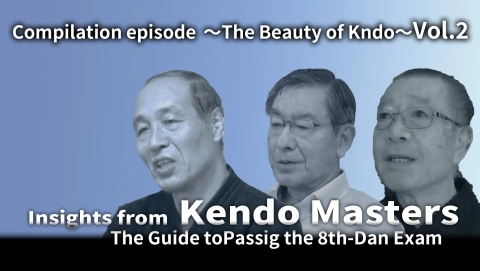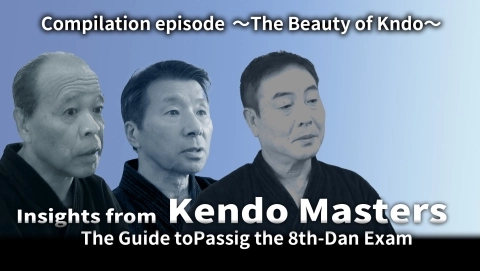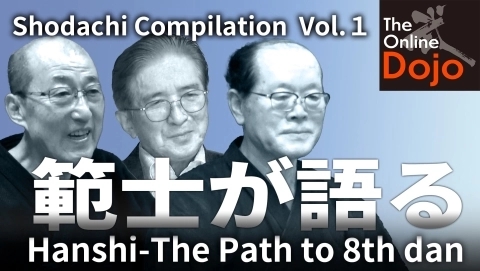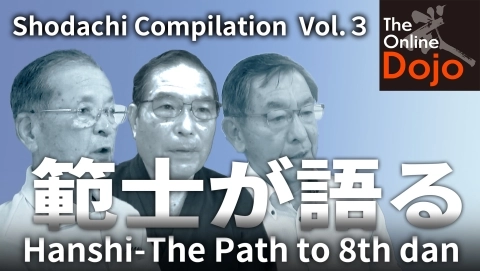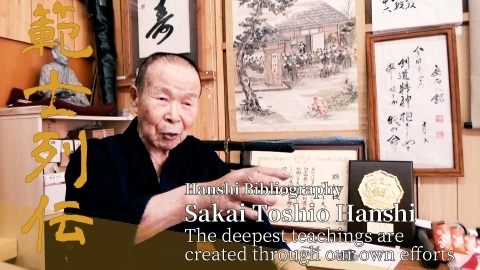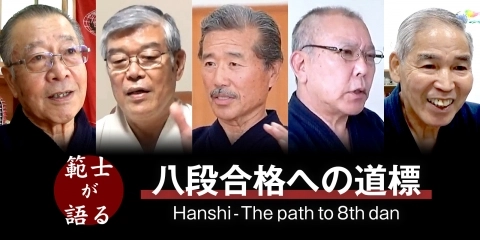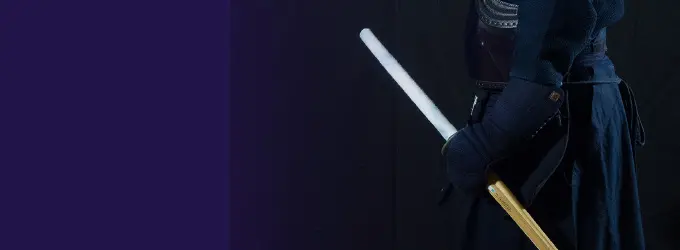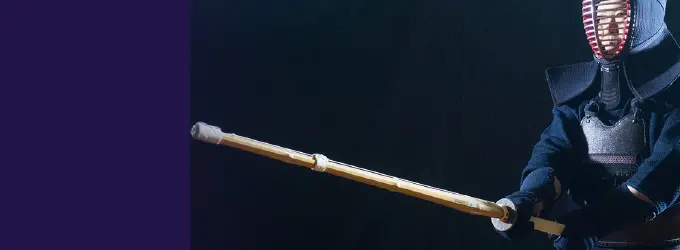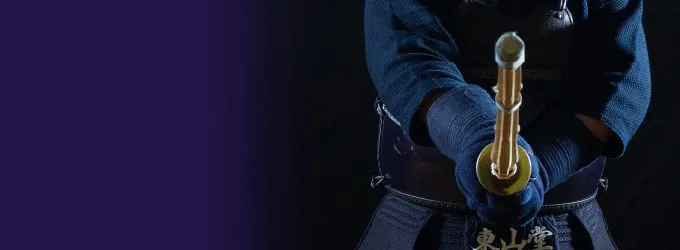Hanshi-The Path to 8th Dan
12 15, 2021

We have asked some of the highest ranked teachers, titled Hanshi, to talk about one of the biggest goals for many people who do Kendo "Passing the 8th dan examination", and we are now releasing these 5 feature-length interviews to the public.
Even if you think that the eight Dan is still a long way a head in your journey, We are sure that you will get a new look on Kendo by listening to the vast knowledge of these Hanshi
What is a Hanshi
"Hanshi" is the highest rank in Kendo.
Dan ranks and titles are all granted by the All Japan Kendo Federation upon passing an examination.
So what does the Dan rank mean?
Currently, in Kendo the time interval between each rank from first dan to the eighth dan is set. So, considering that the earliest you can get the first Dan is at 13 years old, means that the earliest possible time you can pass the eight Dan is at 46 years old.
In the first place, it is not possible to take an eight-dan examination without many years of practicing, but it is said that the pass rate at the examination, which is held only once a year, is less than 1%. That is why it is seen as a very narrow gate by many Kendo practitioners.
There are also three "titles" in Kendo: Renshi, Kyoshi and Hanshi.
==================
Requirements for the exam
Renshi
Requirements: Having received 6th Dan.
Those who have received the 6th Dan and have gone through the obligatory waiting period, can be recommended by the head of their local representative group to become Renshi, if they have been selected for recommendation by the local representative group.
Kyoshi
Requirements: Having received 7th Dan and the title of Renshi.
Persons who have passed the obligatory waiting period after receiving the 7th dan, have been selected by their local representative group and have been recommended by the head of the local representative group may be promoted to Kyoshi.
Hanshi
Requirements: Having received 8th Dan and the title of Kyoshi.
Those who have been recommended by the head of their local representative organization after an obligatory 8 year waiting period after having passed the 8th dan, or those who have been qualified by the chairman of the All Japan Kendo Federation.
==================
To become a Hanshi you need to live up to these ideals as described in the “Regulation regarding rank and titles in Kendo, Iaido and Jodo”. "A Hanshi must be a person who is proficient in swordsmanship, is mature, has excellent wisdom, and is noble in personality and virtue."
Deep knowledge of kendo and contribution to the spread of kendo are also required, such as achievements as a kendo practitioner, instructor or academic achievements and lectures.
Personality and dignity are of course also required
Table of Contents
- 1.Takeshi Masago Hanshi
- 2.Yuji Nakata Hanshi Part1
- 3.Azumori Toyomura Hanshi
- 4.Kiyonori Nishikawa Hanshi
- 5.Katuhiko Tani Hanshi Part1
- 6.Hironori Tahara Hanshi
- 7.Yasuhiro Suzuki Hanshi
- 8.Masateru Ogata Hanshi
- 9.Isao Oshitari Hanshi
- 10.Tadanori Ota Hanshi
- 11.YoshifumiI Shizuka Hanshi
- 12.Sanae Tanaka Hanshi
- 13.Keio Sato Hanshi
- 14.Hiroi Yamashiro Hanshi
- 15.Sunao Tonami Hanshi
- 16.Kouji Kato Hanshi
- 17.Kunio Hayashi Hanshi
- 18.Mituru Hamasaki Hanshi
- 19.Shinji Shimizu Hanshi
- 20.Haruhumi Itou Hanshi
- 21.Masaharu Kakehashi Hanshi
- 22.Kazuo Furukawa Hanshi
- 23.Takashi Futagoichi Hanshi
- 24.Makoto Tajima Hanshi
- 25.Shigeaki Inoue Hanshi
- 26.Taizan Shimano Hanshi
- 27.Hidetoshi Miyagawa Hanshi
- 28.Kunihide Koda Hanshi
- 29.Yoshimi Higashi Hanshi
- 30.Hitoshi MurakamiI Hanshi
- 31.Kazuyosi Okada Hanshi
- 32.KenichiI Shida Hanshi
- 33.Kiyokazu Shimojima Hanshi
- 34.Isato Matsuda Hanshi
- 35.Isao Matsuda Hanshi
- 36.Nakata Yuji Hanshi
- 37.Tani Katsuhiko Hanshi
- 38.Tonami Sunao Hanshi
- 39.Tahara Hironori Hanshi
- 40.Sato Keio Hanshi part2
- 41.Ishiduka Yoshifumi Hanshi part2
- 42.Tanaka Sanae Hanshi part2
- 43.Futagoishi Takashi Hanshi Part .2
- 44.Furukawa Kazuo Hanshi Part .2
- 45.Koda Kunihide Hanshi Part .2
- 46.Shimano Taizan Hanshi Part .2
- 47.Tajima Makoto Hanshi Part .2
- 48.Ogata Masateru Hanshi Part .2
- 49.Masago Takeshi Hanshi Part .2
- 50.Tajima Makoto Hanshi Part .3
- 51.Takahashi Toshiaki Hanshi
- 52.Reiho Compilation Vol.1
- 53.Reiho Compilation Vol.2
1.Takeshi Masago Hanshi

Watch video: https://gen-universe.com/ja/video/537
I had the pleasure of interviewing Masago Sensei at Seidokan in Higashi-Nippori, Arakawa-ku, Tokyo. As he walked from the station on a light rainy day, he looked vigorous and hearty in his old age. After retiring from the National Police Academy, he served as a key member of the All Japan Kendo Federation and was active in teaching both professionals as well as general practitioners. What impressed me most were his words, "You shall be honored with harmony.”
Although there is the positive aspect of getting along with one another in "harmony," lukewarm harmony is useless. How does one live in a society of mixed interests without becoming a losing dog in the fight and without compromising? This is about the need to have something called ‘strength’ to rely on. I listened to his words and thought that it connected to the strength that budo contains that makes us capable of stopping conflict from occurring.
Though the topics he spoke of were very serious, his Kansai dialect allowed me to relax and enjoy listening to him speak. On the way back to the station, he was kind enough to see some random young man like myself off until I was completely out of sight. His back was straight, and his chest was out. I felt the value in showing through actions that kind of care and kindness.
H.
- GEN Editorial Staff
2.Yuji Nakata Hanshi Part1

Watch video: https://gen-universe.com/ja/video/384
If you do not do the match with a felling of winning and then hitting, as opposed to hitting and then winning, then I will not give you a passing mark.
If you are a referee on a regular basis, you probably know that the requirements for a valid strike is "full spirit, proper posture, that the striking part of the Shinai strikes the target correctly and Zanshin".
A valid strike is of course important in the promotional exam, but Nakata Hanshi says that, “it is not enough to just meet the requirements a such a strike in order to pass the 8th dan”.
He says "A Valid strike is the same from the first Dan to the eight,But the substance have to change. A 6th dan level strike becomes 6th dan, a 7th dan level strike becomes 7th dan”.
He continues, “for the 8th Dan, it is not enough to make a valid strike that meets the requirements, You must make a strike that has good timing, hitting as the opportunity presents itself, using proper body and hand movements, and has strength and sharpness, which are the elements of an effective impact".
Also, "Kendo is not only about hitting first. The person who can attack their opponent and hit the place where the opponent has become weak shines in a group of four people”.
Whether you are winning by your attack and throwing a strike is clearly visible to the Judges.
By his talk, I understood that it is possible to pass the 8th dan by practicing while paying attention not only to the requirements for a valid strike but also to these other factors.
M.
- GEN Editorial Staff
3.Azumori Toyomura Hanshi

Watch Video: https://gen-universe.com/ja/video/541
Toyomura Sensei has been cooperating with me on product videos and training at Rensei Kaikan for several times. Sensei's Kendo is strong in spirit and he is delicate with a sword. He could not be perturbed by a desperate ki-seme or ken-seme at all. When a last-ditch effort waza was used, it was treated with ease, judged, and struck. Each attack was dealt with with ease and in the moment that each was dealt with the instant and clarity in which it was done remains clear in my mind.
I solved the mystery. “The output of spirit is proportional to your physical output!”
These words are burned into my brain. The more you give out strong spirit, the more you use your body to relax, the more you become fully energized. The more relaxed you are, the more relaxed your body becomes, the more real power comes from relaxation.
No one is a top-notch athlete in any sport with tense shoulders. I always felt my teacher was an aloof and elusive person. “It's a special talent to be able to work hard. I don't have that talent," he said, "so don't think too hard and just relax. That's why I don't think too hard and just relax. (Laughs) The experience of being an 8th dan evaluation examiner...you can't copy that.”
This is what draws people to the 8th dan Sensei and what gives them that allure.
H.
- GEN Editorial Staff
4.Kiyonori Nishikawa Hanshi
Watch video: https://gen-universe.com/ja/video/377
“In preparing for the 8th dan exam, if you are able to create a self that is unmoving – then there is nothing to fear.”
While practicing for the promotion examination, I remember feeling anxious about failing
Especially for the eight Dan examination, the pass rate is very low, less than 1%.
Even Nishikawa Hanshi, who won the All Japan Kendo Championship, was worried for his test.
" When I was 44, Two years before I was my eight Dan exam, I thought about running away to a remote island", says Nishikawa Hanshi.
The reason for this fear he said is, that after having received so much instruction at the Metropolitan Police Department, If he were to fail, he would not be able to return because of the shame.
However, as he says "My Kendo was no good at all throughout High school but, after joining the police force at age 20 and up until now I have been practicing more than anyone else. And I have become one of the best in Shiai. I found something like that (which I can be confident about) within myself”.
He continues, “Up until that moment, I thought it would be tough to become one of the 10 out of a 1000 people who would be accepted, but I aimed to be the one in a 1000 people without running away. By thinking like that I was able to overcome the 1% pass rate barrier".
Finding confidence like that in yourself will help to reduce the anxiety you feel about the exam. Also, until the day of the promotion examination, turn your anxiety into confidence by making an effort that is greater than anybody else.
M.
- GEN Editorial Staff
5.Katuhiko Tani Hanshi Part1

Watch video: https://gen-universe.com/ja/video/539
I had the opportunity of interviewing Tani Sensei in Takasaki City, Gunma Prefecture. I had the pleasure to speaking with the Sensei previously at the Kyoto Taikai where I had received the impression that he was a kind and gentle person. This is hard to imagine from his strong attacks and sharp techniques when he is practicing kendo.
I met him in the parking lot of a restaurant near his home and interviewed him at a nearby dojo where he was training. It is a magnificent private dojo located in the home of a kendo friend of the Sensei.
He was a classmate of Kada Hanshi at the University of Tsukuba and became Hanshi at the same time. My own impression was that Kada Sensei was drawing in waza with his strong command of the situation, while Tani Sensei applied the brakes from time to time in order to provide logistical support...and then-
a memorable story.
“Etiquette starts and ends there.”
We learn the basics while overcoming a great many things, only to return to the basics.
The most important thing is still the basics.
As Sen no Rikyu said, "Learn from one, know how to get to ten, and then return to one.”
That is what he said.
The impression that Tani Sensei gave me was of the person who had reached ten and attained everything he could there – and then returned to one.
H.
- GEN Editorial Staff
6.Hironori Tahara Hanshi

Watch video: https://gen-universe.com/ja/video/596
"An unconscious strike that is suddenly executed from the beginning position (at the harmony of the spirit, the sword, and the overall body posture) touches the hearts of the judges."
When you practice kendo, you often times hear that it starts with discipline and ends with discipline.
Many studios and schools teach discipline first to beginners. To that extent, discipline is an important factor in kendo.
I myself try to become a good example of the discipline when I am in a practice with the boys and girls. However, I had a self-reflection when I heard what Dahara Hanshi thought about discipline.
Dahara Hanshi says, "The heart of discipline respects the opponent. The gratitude and respect towards the opponent’s conscience are at the roots of it."
He also added that, "Thoughtless greetings without looking at the opposite person should not be done. It’s because there is no heart to such a disorderly greeting."
He has requested our leaders to always teach the boys and girls a great discipline. Whenever I have engaged myself in a practice, I was always cautious to discipline my movements. However, if I don’t get hold of the heartfelt discipline all the other days, the judges will see me clear through and detect my untruthful discipline. Thus, it should not be all about passing the evaluation or not, but there is a need to pass on to the next generation the proper discipline by first implementing that truthful discipline to my daily life and becoming the good example of it, reflecting upon the ideology of kendo; ‘Human Formation’.
M.
- GEN Editorial Staff
7.Yasuhiro Suzuki Hanshi

Watch video: https://gen-universe.com/ja/video/269
“If you are aiming for the eight Dan, you must use Shodachi,
then make your striking Kendo into cutting Kendo”
When I watch a Shinsa I sometimes think to myself “If I was the judge then I would have given that person a Yukodatotsu for that strike, so why did he not pass?” The reason is what is called “not hitting, not cutting”
Suzuki Hanshi says “In a Shinsa there is little value in a strike that is based in winning competitions”. ”Why are you striking, why are you cutting, these are the things that I pay attention to when I judge a examinee”.
He also says that, “Even if the opponent blocks or escapes the strike, if it is done as a proper cut it has value”
At the 8th Dan Kendo workshop lecture, it was said that “In todays Kendo there is “Kendo” and there is “competition Kendo”.
Most Kendoka are focusing on winning in “competition Kendo””.
It is necessary to raise your left hand to in front of your mouth to perform kendo that cuts and hits instead of juts striking Kendo.
In fact, Norishi Suzuki Hanshi passed the eight Dan examination by fighting with the awareness of cutting and hitting.
In order to pass the high-ranking examination, it is not enough to just practice striking that is effective in a competitive setting, but it is important to practice with a focus on the qualities that are required in order to actually cut your opponent.
M.
- GEN Editorial Staff
8.Masateru Ogata Hanshi

Watch video: https://gen-universe.com/ja/video/597
When it comes to the importance of etiquette, manners are something that will are often taught in regular keiko and during seminars. Furthermore, in youth kendo grading examinations, if the rei performed is not simultaneous or if someone does not do taito correctly they may be scolded on the spot.
Ogata Hanshi states that, “Kendo cannot be done alone. You are only able to make strikes because you have a partner.” Certainly, actually striking a partner is central to keiko in kendo. Without this respect being shown between both partners, it would simply be a match striking each other with shinai. That is why you must feel gratitude and respect towards your opponent when you perform this etiquette. Ogata Hanshi also says, “It’s only because you have an opponent that you are able to win.” For shiai, displaying good etiquette to the opponent you are about to face through behavior and with respect is something that must be done.
You may then be able to express a profound gratitude in your heart for having an opponent, only because of whom you are able to take part in keiko.
9.Isao Oshitari Hanshi

Watch video: https://gen-universe.com/ja/video/598
'In order to pass the evaluation, you have to work with the belief that you will pass and your body and mind have to be healthy at the same time.’
Training Kendo with daily practices leads to endless challenges. In order to handle the challenges, we try to devise ways to put gaps in between practices or make opportunities for strikes, but it often fails. In such cases, the Japanese Kendo Form practices could offer a solution.
Oshitari Hanshi says, ‘Form is the starting point of kendo. The distance, strike spot, lunge spot, and the connection of the spirit are important.’ The form practice is not merely about getting your body used to the flow before the evaluation, but it is important to also understand and practice how to counter the movements of the opponent.
By practicing based on the Japanese Kendo Form, one will be able to learn the right distance and opportunity of a strike. Even in a limited time, I am willing to cooperate with my colleague to engage myself into a form practice.
M.
- GEN Editorial Staff
10.Tadanori Ota Hanshi

Watch video: https://gen-universe.com/video/644
Many times, keiko will place in the evening, which makes it difficult to maintain for a long time. So, unlike with students, it is not suburi, kiri-kaeshi, ichi-komi, or kihon-uchi that is most focused on, but jigeiko. Focusing on jigeiko, the core teachings of suburi begin to be lost and the fundamentals begin to break down.
“Fundamentals are not something that is merely for beginners. Each level has its own fundamentals,” says Ota Hanshi. He is always looking to see if the tenouchi that is learned in basic keiko is being applied when strikes are being made. “No matter how good the timing on striking at an opportunity, if this tenouchi is not employed, it will not be considered a yukodatotsu strike. However, if it is employed, it will certainly be considered an ippon,” he says. That is just how important the fundamentals are.
For those who are unable to have keiko at work as police officers are able to, they must compensate the time for fundamental keiko. Doing suburi at home and compensating for lost tenouchi training would seem to be the quickest route to passing a grading.
11.YoshifumiI Shizuka Hanshi
 .
.
Watch video: https://gen-universe.com/video/624
“The most important thing in kendo is posture. It is the first part of employing any technique and so it must be beautiful.”
-Ishizuka Yoshihumi Hanshi
Many kendo practitioners focused on victory in competition in their youth. However, yukodatotsu in shiai may not be appraised the same in a grading examination. There are more than a few kendo practitioners who struggle with that distinction. Ishizuka Hanshi himself had a time when he struggles with this difference.
He told us, “I ran into a wall at my 7th dan. At my first 7th dan examination I only felt that I needed to strike, but the judges were unmoved by this.” He continued, “In shiai I was simply hitting my opponent. It is not merely hitting that is needed for shinsa, but actually striking.” Ishizuka Hanshi believes that in order to perform proper strikes, mitori-geiko is effective. You are able to understand the opportunity to strike and your proficiency will also increase. Even a practitioner such as Ishizuka Hanshi had difficulty with differentiating between shinsa and shia, but the solution he discovered in performing mitori-geiko is one type of keiko that anyone can do. It is important to remember the importance of making use of the time while waiting for jigeiko to perform mitori-geiko as well.
M.
-GEN Editorial Staff
12.Sanae Tanaka Hanshi

Watch video: https://gen-universe.com/video/626
When we see shiai these days, as soon as you hear ‘Hajime’ both individuals move slowly in while guarding until they meet in tsuba-zeriai. Though it may be the way a shiai is structured in the minds of the competitors, it creates an uneasy feeling. Tanaka Hanshi explains the reason for this unease as he spoke.
Ota Hanshi had once believed that even if you were struck with the shodachi, you could always turn around and gain it back with the next strike. However, Hanshi 9th Dan Morishima Tateo Sensei said to him, “In kendo, If you are cut down once with a katana, it’s all over.” From then on his kendo changed so that he no longer went in to strike without thought, but that he would devise his seme as he carefully moved in to strike. This single point carried over into gradings so that if he were struck from the shodachi he would feel that it was already over.
When you think of kendo as a sword duel where someone will be cut down, even if guarding it is not easy to close the gap between you. If you apply this process to the shodachi with this feeling of tension, then you will approach the air and quality of the higher dan levels will be born.
13.Keio Sato Hanshi

English Translations Coming - January 20, 2021
Watch video: https://gen-universe.com/video/622
“If you are able to make strike at a good opportunity with firm tenouchi and correct hasuji, you will receive a passing grade.” – Sato Keio Hanshi
When it comes to the grading examinations for kendo, the 1st dan to the 5th dan are overseen by the prefectural federations, while 6th dan and above are held by the All-Japan Kendo Federation. While the averages may vary by prefecture, 6th dan pass rates are lower than that of 5th dan pass rates. For those who are aiming for the 8th dan, the 6th dan exam is the first hurdle.
“One cause for this hurdle,” Sato Hanshi points out, “is that one’s kikentai-icchi must be unified.” It is ideal for the strike to be made on the correct striking point with the shinai, while at the same time doing fumi-komi. He also says that while it is often the case that the strike is made before fumi-komi is done, these examinees will not pass. “It’s really something that they were able to pass the 5th dan,” he says equivocating.
Many who have done plenty of keiko may feel that they “have got it down,” but in reality, often times they do not. The quickest route to achieving this, to put it bluntly, is to return to and rethink the fundamental basics.
M.
- GEN Editorial Staff
14.Hiroi Yamashiro Hanshi

Watch video: https://gen-universe.com/video/645
“It is about whether the examinee’s kendo has become a work of art or not.”
-Yamashiro Hiroi Hanshi
In shiai or shinsa, many people have difficulty maintaining a calm spirit. They may have trouble doing things which they are able to do in regular keiko or may find themselves becoming very tense. So, how is it one can display what they are capable of during regular keiko when taking a shinsa or in a shiai?
According to Yamashiro Hanshi, it is good to take the concepts of an unmoving mind or a calm spirit and make them your own. He would often find himself having conversations between the ‘self’ within his spirit and the ‘self’ within his body. “The ‘self’ that resides in my body would work extremely hard in keiko, but when it came to a shinsa, the ‘self’ from within my mind would appear saying ‘Let’s do this’ or thinking ‘I’ll try and do that.’ When this happened, the balance between my body and spirit would break down.” This could mean that even when trying to do just as he had practiced in keiko, this ‘self’ within his mind would create thoughts that would cloud his mind. Yamashiro Hanshi believes that many people fail because their balance has broken down in this way. In regular keiko, when going against an experienced sensei, we have a deep yearning to create a strategy and strike using yukodatotsu.
When this feeling appears, being able to control yourself and devise plans during regular keiko may be the secret that having a tranquil spirit holds.
M.
- GEN Editorial Staff
15.Sunao Tonami Hanshi

Watch video: https://gen-universe.com/video/599
High level dan grading examinations match duration times are decided at 1 minute for 6th dan, 1 minute 30 seconds for 7th dan, and two minutes for 8th dan. If within this very short exam time you are struck with a yukodatotsu strike even once, it is very difficult to retain the control of the match. With this uneasiness, it requires a great deal of bravery to make a fully committed strike.
Tonami Hanshi says that if you are able to strike “in the instant when it feels right to me,” then you will have made a good impression. Moreover, “Even if the strike is not yukodatotsu, but the movements of the strike are made with great spirit and are fully committed, then it may get a passing grade.” The judges are waiting for strikes made at the opportune moment. Furthermore, the strike must also strike a chord in the hearts of the judges.
The mental state of the examinee is wanting to make a yukodatotsu well, while not being struck. However, by simply breaking down the opponent and making a yukodatotsu strike is not enough to move the judges. It requires the courage to look for learn the moment when you really feel that ‘this is it’ without being overly concerned with a yukodatotsu strike. To that end, in regular keiko, you have to fail multiple times while ingraining this into yourself.
16.Kouji Kato Hanshi
English Translations Coming Soon
"When I am an examiner at a kendo dan promotion, I pass the examinee if I think that his style is appropriate for that dan rank even if he does not strike."
In the process of training to pass a high dan examination, I have heard the phrase "competitive kendo" used.
This term is used to describe a style of kendo that focuses on winning matches and uses a lot of defensive postures and strikes.
This style may be a part of kendo training, but in order to pass a high dan examination, this style may need to be changed.
"When I was watching the 8th dan examination, I noticed that some of the examiners were watching the opponent's movements before striking. It's too late for them to be watching their opponents before striking, they need to be ready to throw themselves away the moment their opponents start to strike." Kato said to me.
Kato also pointed out a shortcomings of the modern style of kendo, "In the old days, kendo was offensive, but today's kendo starts with defense, so even in the examination, the left hand is off the midline and strays from the real use of the sword."
He also pointed out the shortcomings of the modern kendo style, saying, "Kendo is not about defending or avoiding the opponent's strike, but about responding with techniques."
In order for the examinee to improve from "competitive kendo" to "correct kendo", he or she must always practice with an attack in mind, not defending, but responding to the opponent's strike.
Practicing with the awareness of responding to the opponent's strikes will bring you closer to passing a high dan examination.
Watch video: https://gen-universe.com/video/676
17.Kunio Hayashi Hanshi
English Translations Coming Soon
"An 8th dan examinee can pass by just understanding the kendo kata."
What are you doing to prepare for your dan promotion examination?
I am making an effort to follow the instructions given by my sensei precisely.
In addition, I go to observe the dan examinations that are held before I take my own examination, so that I can predict my opponent's level of ability when I take the exam. I thought I carefully prepared for the examination.
However, the preparation that Hayashi Sensei made for his 8th dan examination was much more specific than I had imagined.
Hayashi Sensei had this to say about the standing position for the 8thdan examination. "The distance and position between the examinee and the examiner is very important, and it is more powerful when the examinee performs the technique close to the examiner." He was also perfect in allocating the two minutes of examination time. He explained the time allocation of the judging in this way, "In the first 30 seconds, we would attack each other and I would show my techniques. Next, I perform another waza at the end of one minute. Next, I show a waza when one minute and thirty seconds have passed. Finally, I show the last waza just before the two minutes are up. I try to use fewer waza in the examination and hope that I can use my each waza at the opportune time."
I believe that each dan examinee has his or her own way of devising and making efforts. It is natural for examinees to practice hard, but in order to pass the examination, the examinee has to perform with the best standing among the examiners. The shortest path to passing the exam is to prepare well for things other than simply waza.
Watch video: https://gen-universe.com/video/677
18.Mituru Hamasaki Hanshi
"It is important for the examinee to practice on a regular basis in order to be able to get a pass from all the judges."
Many kendoka practice kendo with the goal of winning a match.
In order for a kendoka to win a match, no small amount of techniques such as feinting and defense are necessary. However, when a kendo practitioner's goal changes from winning a match to passing a dan promotion, he must change his way of thinking.
When talking about training with the goal of passing the dan, Hamasaki said that his sensei had given him this instruction. "You have to change the way you think about kendo. When you practice kendo, you can't pass the dan examination just by hitting hard. You must practice kendo with an emphasis on the mental aspect."
As a member of the Metropolitan Police Department's kendo team, Hamazaki practiced with the aim of winning matches. Therefore, he was able to react quickly to his opponent's movements. However, the judges viewed this as not having a calm mind and led to a bad evaluation. To avoid being misunderstood by the judges, Hamasaki tried to reduce the number of unnecessary strikes in his training.
Watch video: https://gen-universe.com/video/679
19.Shinji Shimizu Hanshi
English Translations Coming Soon
"When judging for a grading, I always pay attention to whether they move from the legs or not."
Shimizu Sensei talked about the common factors for candidates who fail the examination. He talked about the common denominator of failed examinees: "The examinee often makes unnecessary strikes, and the examinee is half-hearted in terminating the strikes. It would be better if the they could make a decisive strike, but many of them are not able to make one because they are confused by the opponent's movement or intention. Shimizu also pointed out that the candidates' kendo bogu at the judging was not aligned, and that the color of their kendo uniform was faded. He said that these points can be improved if the examinee is aware of them, so they should be checked before the examination.
The items pointed out could not be improved simply by the examinee practicing hard. As for the issue with the examinees hesitating depending on the opponent's movements, it is necessary for the examinee to have the spirit to have faith in their own kendo during keiko and to be determined when facing any opponent.
In addition, I think one of the ways to improve examinee dress is to be conscious of dressing neatly on a regular basis, and to have someone around you check your appearance in a mirror and look at your appearance objectively. What I learned from listening to Shimizu's talk is that it is important for the examinee to always approach practice with the attitude and attire of an examinee.
Watch video: https://gen-universe.com/ja/video/680
20.Haruhumi Itou Hanshi

"Kendo is not only about winning and losing, but also about being dignified like a lord.
In order for a kendo practitioner to pass the examination for a higher rank, he or she has to improve his or her dignity and style. However, I believe that it is difficult to improve dignity and style, which are invisible to the naked eye, unlike the techniques of striking and footwork. I am sure that there are kendo practitioners who have the same problem as the author. For those of us who have such problems, I thought that the way Ito Hanshi thinks about it might be a clue to solving our problems.
After retiring from his position as a special trainer, Ito Hanshi became an instructor. At that time, he remembered a frase that had been said to him by Mr. Asahide Koyama, who was the hanshi of the Takushoku University Kendo Club, where he was the captain. He said, "In a kendo team competition, it is only the vice captain who cares about winning. The general is the team's lord. The general is the general of the team. If you do kendo with that kind of dignity, you won't have to worry about winning or losing. These were his words. I still believe that kendo should be the lord's kendo. The imposing kendo of a lord, he said. While attempting to maintain this idea of doing kendo with the quality and dignity of a lord, he was promoted all the way to 8th dan.
If we imagine a person or a position with quality and dignity, it may be easier to embody it. The first thing I am going to
Watch video: https://gen-universe.com/video/695
21.Masaharu Kakehashi Hanshi

"kendo practitioner start training for their 8th dan examination the day after they pass their 7th dan examination.
When a kendo practitioner passes the examination of his target dan, he may feel a sense of accomplishment, satisfaction, and relief, and think that he should take a short rest before planning and practicing for the next dan.However, Master Lung says that this way of thinking is wrong.
He says, "I passed my 7th dan examination.If a person who has passed the 7th dan examination practices with an easy mind, he will lose his 7th dan ability.
That's why a person who has passed the 7th dan examination must start practicing the day after passing the examination.
Otherwise, even if that person starts practicing for the 8th dan examination after some time has passed, he or she will have to start practicing from the point where the 7thdan ability is developed.
He also said, "If a person continues to practice seriously from the next day after passing 7th dan, he will have 8th dan ability in 10 years.
When I listened to him, I realized that continuity is power.If my goal is to pass the 8th dan examination, I think it is important to think of passing 7th dan as a passing point.He also said, "I have never enjoyed practicing.He said that he often asked to practice with strict instructors who would not let him practice even if he asked.In order to pass the narrow gate of 8th dan, we have to be strict with ourselves.
Watch video: https://gen-universe.com/video/525
22.Kazuo Furukawa Hanshi

"If you can hit where your opponent's mind is trying to move, you can pass the dan test just by hitting one.
When I was training for my dan promotion test, I often received advice that I should not hit too hard.
However, when I actually observed a dan promotion examination, I wondered, "That examinee looked like he was hitting too hard, but why did he pass? "The answer to this question was given by Furukawa Hanshi.
The answer was found in a talk by Furukawa Hanshi.
He said, "If you can hit where your opponent's mind is trying to move, you can pass the dan promotion examination with just one strike." This means that if you can strike at least one point in the attack or defense between you and your opponent where your opponent's mind is trying to move during the examination time, you may pass the examination if you can strike at that one opportunity. If there are many opportunities, the number of strikes will inevitably increase. The phrase, "Don't hit too hard" refers to unnecessary strikes made when the opponent's mind is not yet in motion.
The sensei who passed the dan examination I observed was striking precisely when the opponent's mind was about to move.
So, what should we do to find out where the opponent's mind is trying to move?
Furukawa Hanshi also talks about this.
Watch video: https://gen-universe.com/ja/video/790
23.Takashi Futagoichi Hanshi
24.Makoto Tajima Hanshi
25.Shigeaki Inoue Hanshi
26.Taizan Shimano Hanshi
27.Hidetoshi Miyagawa Hanshi
28.Kunihide Koda Hanshi
29.Yoshimi Higashi Hanshi
30.Hitoshi MurakamiI Hanshi
31.Kazuyosi Okada Hanshi
32.KenichiI Shida Hanshi
33.Kiyokazu Shimojima Hanshi
34.Isato Matsuda Hanshi
35.Isao Matsuda Hanshi
36.Nakata Yuji Hanshi
37.Tani Katsuhiko Hanshi
38.Tonami Sunao Hanshi
39.Tahara Hironori Hanshi
40.Sato Keio Hanshi part2
41.Ishiduka Yoshifumi Hanshi part2
42.Tanaka Sanae Hanshi part2
43.Futagoishi Takashi Hanshi Part .2
44.Furukawa Kazuo Hanshi Part .2
45.Koda Kunihide Hanshi Part .2
46.Shimano Taizan Hanshi Part .2
47.Tajima Makoto Hanshi Part .2
48.Ogata Masateru Hanshi Part .2
49.Masago Takeshi Hanshi Part .2
50.Tajima Makoto Hanshi Part .3
51.Takahashi Toshiaki Hanshi
52.Reiho Compilation Vol.1
The first thing you are taught in Kendo is Reiho; not Suri-ashi, not Soburi, but Reiho. This is also what you spend the most time practicing. We are taught how to sit, how to meditate, proper angles from which to bow, and even our posture. The higher the rank, the stricter the scrutiny, and sometimes even if the content of their kendo is good, the student may be rejected because their etiquette was lacking. The following is a summary of what Hanshi have to say about such etiquette.
By incorporating the way of thinking and perception of Reiho by the highest ranking Kendo practitioners, as well as our own efforts to acquire this level of Reiho, we may be able to improve our own Reiho considerably.
https://gen-universe.com/video/2252
53.Reiho Compilation Vol.2
The first thing you are taught in Kendo is Reiho; not Suri-ashi, not Soburi, but Reiho. This is also what you spend the most time practicing. We are taught how to sit, how to meditate, proper angles from which to bow, and even our posture. The higher the rank, the stricter the scrutiny, and sometimes even if the content of their kendo is good, the student may be rejected because their etiquette was lacking. The following is a summary of what Hanshi have to say about such etiquette.
By incorporating the way of thinking and perception of Reiho by the highest ranking Kendo practitioners, as well as our own efforts to acquire this level of Reiho, we may be able to improve our own Reiho considerably.
https://gen-universe.com/video/2332













































